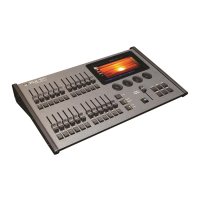Zero 88 FLX S Lighting Console – User Manual Page 24 of 47
Cue Settings
Cue Setting can be changed via the “Cue Setup” window.
To open this, press Settings button of the cue required,
under the settings column of the Playback Window. The
Cue Setup window appears:
Cue Setup window
Trigger (Go, Auto, Timecode etc)
This option allows you to change what’s going to trigger
each individual cue. By default, this is “Go”, but the
following options are available:
GO
This option will only trigger the selected cue when
the Go button is pressed. This is the standard way a
cue is triggered, and is chosen by default.
Auto (with previous cue)
This will trigger the selected cue at the same time as
the previous cue. For example, when you press Go on
the previous cue, this cue will also be triggered and run
at the same time. When this option is selected, a “Wait
Time” field will appear just below the drop down. This
allows you to enter a wait time, for example 5 seconds.
This means the selected cue will be triggered 5
seconds after the previous cue is triggered, even if the
previous cue is still running as it’s fade time is longer
than 5 seconds.
Auto (after previous cue)
This option is similar to above, but it will trigger the
selected cue only once the previous cue’s fade time has
been completed. Again, when this option is selected, a
“Wait Time” option will appear under the drop down.
Next cue
“Next cue” is the cue number which automatically gets
selected after this cue is executed. This functionality is
very useful if a scene is “cut” from the show – you can tell
FLX S to skip the cues in that scene and jump straight to a
different cue. If this field is empty, FLX S will automatically
select cues sequentially.
Don’t Move on Dark settings
This option allows you to disable a specific attribute from
moving in dark during this specific cue. For example, you
may not want colour scrollers changing during a very quiet
scene, so during that scene “Don’t Move Colour” can be
selected. For more information about this, see “Move on Dark” on page
“19”.
Macros
Macros allow you to trigger (and release) other playbacks
automatically during this cue. For example, if you want a
chase on cue 20, you could create that chase on a
separate playback, and then trigger it from Cue 20 in your
Master Playback.
To do this, press the “Add” button next to either of the two
options. This will open a new window which displays all the
Playbacks. Select the Playback you wish to trigger. This
will add it into the previous window. You can repeat this to
trigger multiple playbacks at the same time. To remove a
playback you’ve added, simply select it in this window.
Once finished, select
the OK button.
Playing back cues
Before playing back the programmed cues, it’s suggested
to remove any unrecorded commands from the command
line by pressing the Clear button twice.
Raising the playback’s fader to full will automatically trigger
the first cue within the playback.
To output the next memory in the playback, simply press
the Go button. Each time you press it, the console will
continue down the list one cue at a time.
Within the Playback window, the green bar shows you the
currently active cue, while the yellow bar highlights the
next cue (which will become active if you press Go ).
You can change which cue is next by tapping a cue. The
cue will go yellow, and become active when Go is
pressed.
Once the end of the playback is reached, the first cue will
be selected as the next cue, resulting in a loop.
Cues that are currently running live can be sped up or
slowed down live by using “Speed Override”, accessible
under the Ⓩ key.

